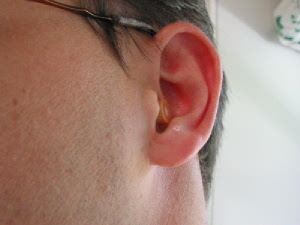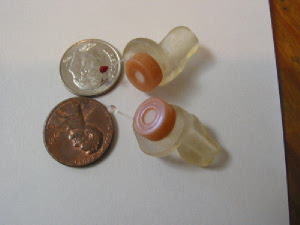Hearing Protection for Sports Officials
[ Back up to vbref.org ]
Ever had ringing in your ears during or after an officiating assignment? If so, you're doing irreversible damage to your hearing! Luckily, you can reduce your exposure... | |
 |
 |
| Custom earplugs shown in-ear. The clear plastic mold and flesh colored attenuators are hardly noticeable even from a few inches away (you probably noticed my needing a shave and haircut first!) , and provide smooth, natural sounding protection that doesn't interfere with speech intelligibility. | My pair of Etymotic musicians earplugs. The beige attenuator "buttons" are easily interchangeable. The tiny clear stalks assist in removing the plug and may be cut off if not needed. The red-tipped one (top) indicates the "right" ear plug, clear is left. Total cost for audiologist fitting, mold, and attenuators: ~$150. However, if you are a referee and not a musician, though, you can actually get even better protection for half the cost ($75) by getting similar looking custom molded Microsonic Double-Damped Model B plugs. |
|
Tinnitus (ringing in the ears) is a warning sign and an indication of excessive
exposure to unhealthy sound pressure levels (SPL). Recent studies
have analyzed various whistles and their SPL levels at the
official's ear and strongly recommend the use of ear plugs for sports
officials who work multiple times a week. One study done by Jim Olson (USAV official, PAVO member,
and safety professional) recommends a 30dB reduction and another
study recommends at least a 10dB reduction or more. Naturally, the greater the reduction, the
more protection you can afford yourself, and both studies indicate
that unprotected whistle use presents damaging sound pressure levels
to the ear. This issue is of particular concern to volleyball officials in
which a whistle blast begins and ends every point of every game. Earplugs are a simple way to reduce your exposure. However, some officials may be hesitant to adopt equipment that is non-standard, or somehow visually distracting. Many off-the-shelf earplugs are designed for industrial use where a supervisor needs to verify that their workers are wearing protective equipment. As such, they tend to come in rather noticeable prominent colors such as neon yellow, or neon orange. Note that flesh colored foam plugs are available, but they still project outside the ear and are noticeable from a distance. Custom-molded earplugs, however, are available from many local audiologists for a modest cost as low as $75! (likely a deductible business expense--ask your accountant! or perhaps even free--ask your HMO!). They provide excellent protection and are very discreet. Unlike foam plugs, they do not interfere with speech intelligibility to a great extent. These plugs are custom molded by an audiologist (a 20 minute visit to take the mold is all that's required) to the exact contours of your ear and ear canal. The result is a very discrete plug that is nearly undetectable even from close distances. There are a few major manufacturers of custom molded plugs including Microsonic, Etymotic Research and Westone Laboratories. I use Etymotic Research custom molded musician's plugs. Westone Laboratories manufactures a wide array of different plugs including a hefty 36dB custom molded plug, and a variety of other models with varying ranges of attenuation and speech intelligibility. Referee Steven Webster forwarded me the excellent information about the Microsonic Sound Defender earplugs that he uses which are custom molded by an audiologist and cost him only $75. His audiologist recommended the Double-Damped Model "B" over musicians earplugs, citing the truth that musicians plugs do let in more high frequency sounds that officials really don't need to be hearing. Attenuation for this model ranges from 19dB at 100 Hz up to 40+ dB at 5000 Hz My Etymotic Er-15 plugs are the "partially countersunk" models and the mold is clear. The only thing visible in the ear canal is a flesh colored button (the attenuator) that is smaller than a dime. The Er-15's are musicians plugs designed for flat frequency response across the sound spectrum. Average attenuation is 15dB. I also use Er-25 buttons in my referee ear molds routinely which provide an additional 10dB of protection (25dB total). Etymotic ER-20's (in beige, preferably) are good for a non-custom (and not as visible as yellow foam plugs) but still extend a bit from the ear. They provide 20dB of noise reduction. I highly recommend custom plugs for anyone involved in loud environments, especially volleyball officials! In addition to their use in officiating, they are also useful for air travel, operating power tools that don't produce dust (dust will clog the filters of musicians plugs), and attending live music performances--anywhere where an inconspicuous ear plug can reduce the fatigue and hearing damage comes with moderate to loud sound pressure levels over extended durations.
-- | |